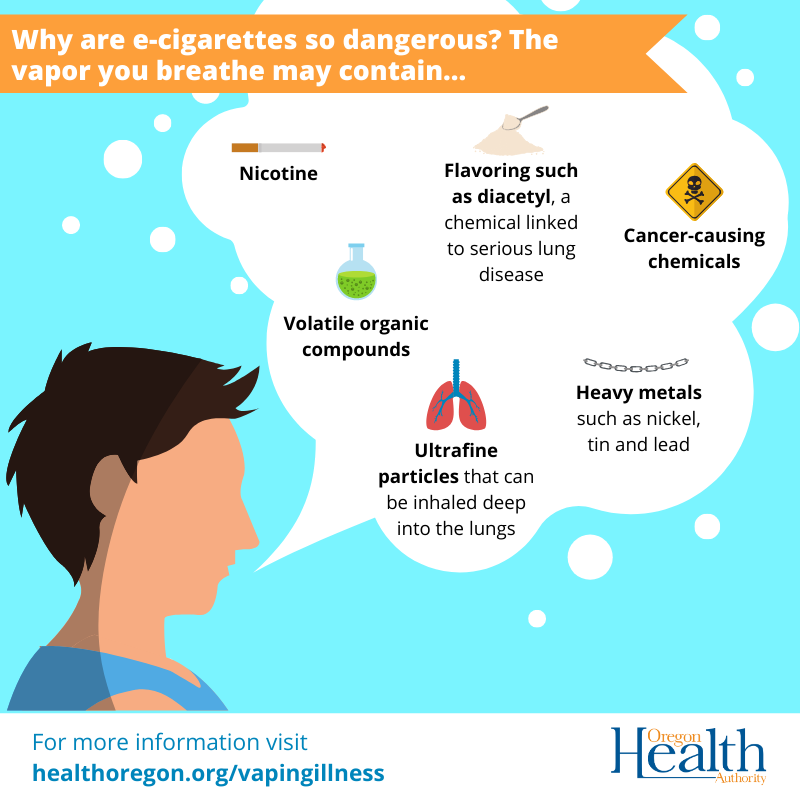Inherent Risks of Electronic Cigarettes
Electronic cigarettes (e-cigarettes) are not harmless. Their aerosol contains multiple toxic substances with documented adverse health effects, posing risks to users and, in some cases, bystanders exposed to secondhand aerosol.
Harmful Constituents in E-cigarette Aerosol
The aerosol inhaled from e-cigarettes is not merely water vapor. Key harmful components include:

- Nicotine: A highly addictive substance. It can impair adolescent and young adult brain development, which continues into the early to mid-20s. Nicotine is also toxic to developing fetuses and poses risks to cardiovascular health by increasing heart rate and blood pressure.
- Volatile Organic Compounds (VOCs): Compounds such as benzene (a known carcinogen found in car exhaust) can be present. At certain levels, VOCs can cause eye, nose, and throat irritation, headaches, nausea, and have been linked to damage to the liver, kidney, and nervous system.
- Flavoring Chemicals: Many flavorings are used to make e-cigarettes appealing. Some, like diacetyl, have been linked to serious and irreversible lung disease such as bronchiolitis obliterans (“popcorn lung”). The long-term safety of inhaling most food-grade flavoring chemicals is unknown when aerosolized and inhaled.
- Carcinogens and Toxicants: Chemicals known or suspected to cause cancer, such as formaldehyde, acetaldehyde, and acrolein, can be formed when e-liquid solvents (propylene glycol and glycerin) are heated. Acrolein can also cause irreversible lung damage.
- Heavy Metals: Metals like nickel, tin, lead, and chromium can leach from the heating coil and other device components into the aerosol and be inhaled into the lungs. These metals are associated with various toxic effects.
- Ultrafine Particles: These particles, smaller than those in tobacco smoke, can be inhaled deep into the lungs and may trigger inflammation, exacerbate respiratory conditions like asthma, and contribute to cardiovascular problems.
Documented Health Impacts
Use of e-cigarettes is associated with several health problems:
- Respiratory System Damage: E-cigarette use can cause lung inflammation and damage. Cases of severe acute lung injury, known as e-cigarette or vaping product use-associated lung injury (EVALI), have been reported, primarily linked to Vitamin E acetate in THC-containing products, but risks from nicotine products remain. Regular use can lead to symptoms like chronic bronchitis and may worsen asthma.
- Cardiovascular Effects: Beyond nicotine’s impact on heart rate and blood pressure, some studies suggest e-cigarette use can contribute to endothelial dysfunction and increase the risk of cardiovascular events over time.
- Nicotine Addiction: The high efficiency of nicotine delivery in many modern e-cigarettes can lead to rapid and strong addiction, particularly in young users. This makes cessation difficult and perpetuates exposure to other harmful chemicals.
- Impaired Brain Development: Nicotine exposure during adolescence and young adulthood can disrupt brain maturation processes, potentially affecting attention, learning, mood regulation, and impulse control, and may increase susceptibility to other addictions.
- Risks During Pregnancy: Nicotine and other chemicals in e-cigarette aerosol are harmful to fetal development, potentially leading to premature birth, low birth weight, and effects on brain and lung development.
- Poisoning Risk: E-liquids, especially those with high nicotine concentrations or appealing flavors, pose a significant poisoning risk if ingested, particularly by young children. Skin contact can also lead to nicotine absorption.
- Device Malfunctions: Defective e-cigarette batteries have been known to cause fires and explosions, resulting in serious burns and injuries.
While some may perceive e-cigarettes as a safer alternative to combustible cigarettes for adult smokers who completely switch, they are not risk-free. For non-smokers, youth, young adults, and pregnant individuals, any use of e-cigarettes poses significant and avoidable health risks.










